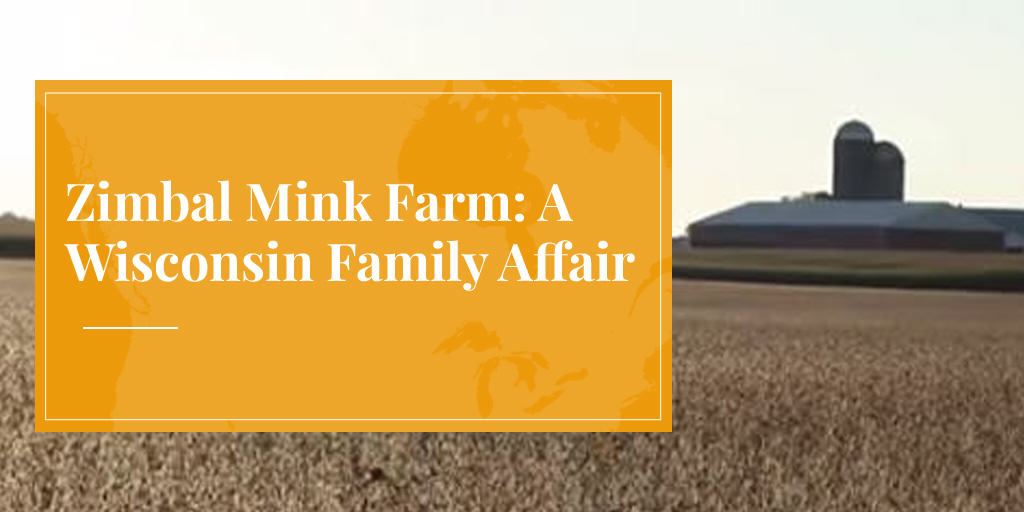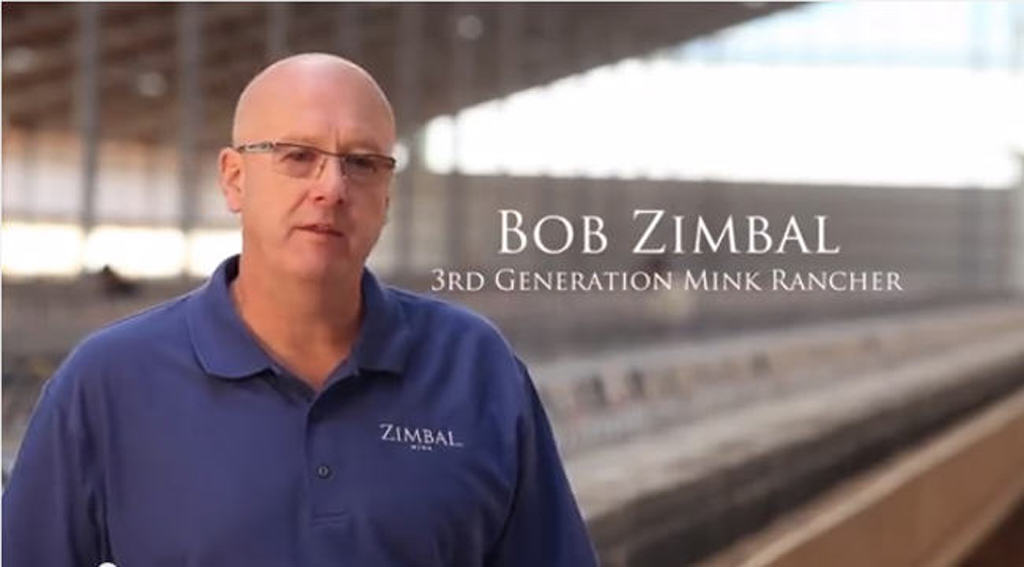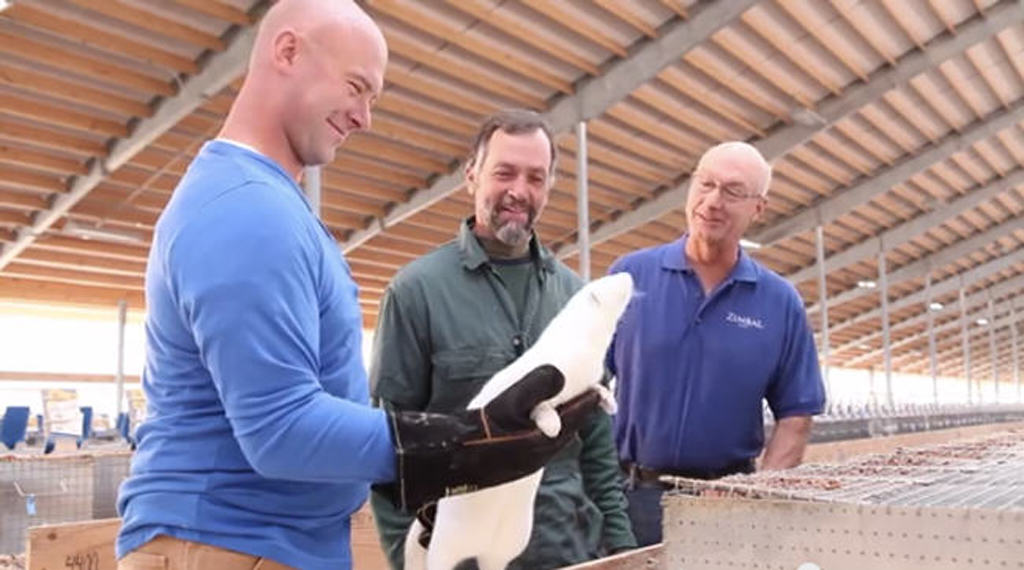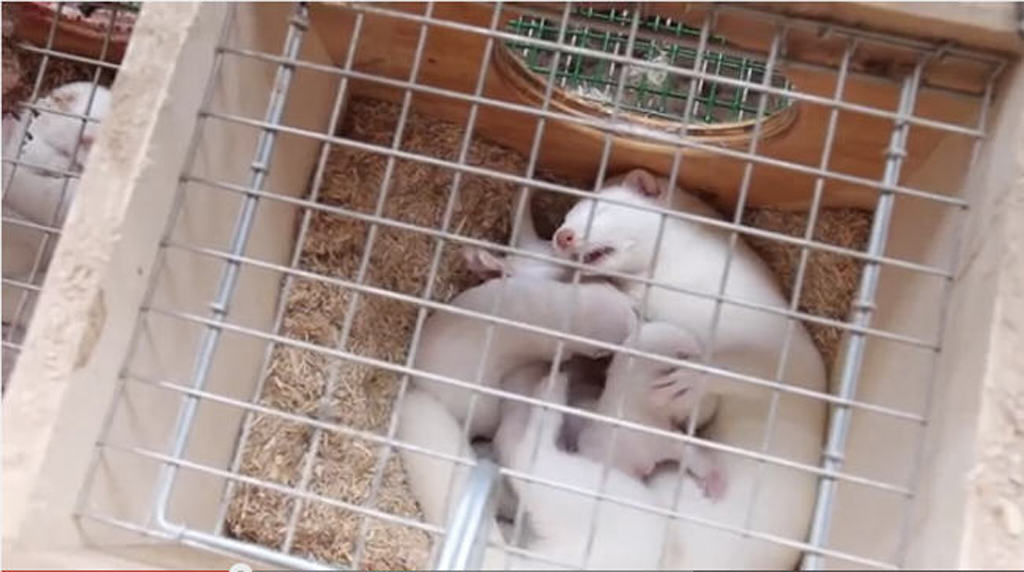
If you’ve never visited a mink farm before, now is your chance! Zimbal Mink Farm is in Wisconsin, the largest mink-producing state in the US (though Utah is not far behind). The farm is larger than most, but has one thing in common with almost every mink farm in the US: it’s a family affair. Now let’s meet the third and fourth generations of this mink-farming family …
BOB ZIMBAL, third-generation mink farmer: So we’re located on the shores of Lake Michigan in Wisconsin, and Wisconsin is actually a great place to raise mink.
Raising mink is a lifestyle as much as a job and when we come out in the morning we look forward to caring for the animals and feeding them and taking care of their needs.
Sixty years ago my grandfather and my father started Zimbal Mink. Mink were just being domesticated, so there was a learning process how to care for the animals and feed the animals. As I child I always helped on the farm, and my father taught me to pay attention to the animals and look at their health and each individual mink’s needs.

My grandfather and my father were kind of pioneers in the industry, teaching and learning what it takes to raise a good-quality mink. And now we’re trying to pass that also the next generation of my sons and my nephew, as they come on to the farm.
The year really begins in the fall of the year where we select the breeders, and it’s all natural breeding on the farm. Breed them in March. And the end of April, beginning of May they have their litters. We are continually monitoring each female to see how she’s caring for those young ones. If there’s some difficulty, we can help them along, or sometimes if a mother can not take care of them, we can move them to the next animal.
SEE ALSO: A YEAR ON A MINK FARM. PART 1: BREEDING
We have a computer system which we use, and that helps us track each individual animal. Years ago when my father did it, it was all done by hand, but now it’s a computer system where we use a bar code, and we’re able to select and look for the genetic traits that we want to keep in the mink.
We look for size; size is important because it’s material that it takes to make the garment. Also we look at the quality of the hair. We’re looking for fine, soft hair on the mink, rather than coarser-type hair. And the thickness and the depth of the underfur is important.
We raise seven different colors, from black to white. There are browns, there are greys in between – lighter greys, darker greys – but we have distinct, different breeds.

Healthy Diet, Healthy Mink
A healthy mink starts with a healthy diet, and in Wisconsin we’re fortunate to have a diverse agricultural community. We have things available to us like beef, cheese, eggs, poultry.
JIM ZIMBAL, fourth-generation mink farmer: The better food helps them grow a nice thick coat, and silky. If we didn’t feed them as well, they wouldn’t turn out as well.
BOB ZIMBAL: I’m not a formally trained nutritionist, but I do work with nutritionists, and at different times of the year, the mink’s needs are different. So when a mink is reproducing, its requirements are different than when it’s growing or furring. So our food is weekly sent in to a laboratory to have it analyzed to make sure that we’re meeting the needs of the mink.
SEE ALSO: A YEAR ON A MINK FARM. WHELPING AND WEANING
The great thing about us taking these animal proteins that are not used for human consumption, we’re recycling that back into the mink industry and using that to feed the mink. So all our food is produced on our site, in our feed kitchen, keeping that food as fresh each day as possible.
We have a brand-new, state-of-the-art facility. We can open the roofs and sides and the air will flow through the building, to keep it cooler in the summer. But also we can close it up in bad weather in the winter to protect the animals from the environment.
Also this facility uses the natural light which the mink are accustomed to.
This facility is designed to make the mink comfortable, but also make it efficient for the people that are caring for the animals. So the way the bedding is put into them, the way the boxes are kept clean – things like that are designed with what’s comfortable for the animal but also what is efficient for the employees.
This facility is really a state-of-the-art facility that is going to be copied by other farmers throughout the world.

JOHN EASLEY, DVM, ranch services veterinarian: Zimbal Mink management techniques are always being developed on the farm here. They are always looking for different ways for them to produce and handle and care for these mink in a better way.
From a health standpoint, as a veterinarian, I look at how the animals are being taken care of on a daily basis.
The Zimbals are an active participant in Fur Commission USA’s Humane Herd Certification Program. During the herd certification process we look to see that the mink are being housed, cared for, fed, managed, to the criteria that are prescribed within the guidelines. By meeting those standards, they consistently produce some of the best-quality mink in the world, and that reflects on their caretaking abilities.

BOB ZIMBAL: My daughter, my son and my nephews and nieces travel the world, like Moscow, London, Milan, Hong Kong, New York, to keep up on the latest trends in the fashion industry. Really, what are these manufacturers and top designers looking for in the quality of the mink?
Buyers throughout the world expect consistent quality from us, and they’re expecting the highest standard in the world. Our quality exceeds their expectations, which makes Zimbal Mink the most sought-after brand in the world.
And it all starts here, on the farm, with our attention to detail.











mine name is Samantha smith and I was just wounding if you had couple of mink for sale and how much for a male mink and a female mink
Hi Samantha, some mink farmers do sell animals, though it’s usually to other farmers. The price will depend on the type of mink. If it’s considered a good breeder and of an unusual colour phase, it will be much more expensive than a regular brown mink. Your next step is to introduce yourself to a local mink farmer, but don’t just turn up at a farm without an appointment. North American mink farms employ strict biosecurity protocols, and don’t want strangers wandering around who might be carrying pathogens. Good luck.
I’m looking for Pure Mink Oil manufacturer for Skin & Cosmetic ingredient who can apply Quarantine Certificate (Health Certificate).
We need it for importing animal oil.
If you know proper manufacterer, please let me know ~
Hi Janny, we may be able to help, and have sent you a private email. Just for background, please read our post on mink oil here: https://truthaboutfur.com/versatile-mink-oil-under-appreciated-resource/
I’m looking to purchase mink oil for my skin. Do you sell it?
I want to buy a pair of young mink to raise not for profit just enjoy taking care of them.
What you do makes me physically ill. How do you sleep at night knowing you are causing such pain and harm to innocent creatures?
To those of you who buy fur – you seriously can’t find anything else to wear?
Karma will always find you. Remember that.
It’s quite sad that people believe the crap that you write about providing a nice home for these animals who are only being raised to be killed. How incredibly sad our human race has become.
Presumably you are opposed to all livestock farming, since all livestock are raised to be killed. If this makes you sad, we’re sorry, but things are not going to change. Man has been using animals for food and clothing since the beginning.
Do you think wild animals live forever? They are all born to die and usually do so by being eaten, run over, starve, or die of disease. Funny thing is I’ve noticed that most people who think like you do are perfectly fine killing a baby who is still in the womb and calling it woman’s choice. That is truly horrific. Not one person on this farm enjoys actually killing the animals. It is the one sad part to any type of animal farming, but it is reality. How cruel YOU are for the dead cow you are wearing on your purse, your boots, or your belt. How cruel YOU are for the chickens, pigs, sheep, cows, and fish you eat. I bet all of those animals were killed as well. Get in touch with reality.
I’m a vegetarian and have been almost my entire life, so no, I don’t contribute to the deaths of fish, cows, etc. And I try to keep my wardrobe clean or animal products as well.
I can appreciate it if these farmers are at least trying to give the animals a good quality of life while they have it – fair enough.
Has anyone asked, or has it been addressed elsewhere, what happens to the mink “meat”? If the mink farmers are proud of the fact that they are helping reduce waste of other animal products by feeding the mink products not suitable to be consumed by humans, that’s great, but what happens to the mink carcasses? Americans don’t eat mink meat (to my knowledge), so isn’t it wasteful to only be using their fur?
I’ve also asked this elsewhere and not got any feedback: How do the mink not contract ringworm from being bedded in wood shavings? Ringworm would ruin their fur. Breeders I know of that breed other fur-covered animals avoid wood shavings for this reason.
Hi Kat, in Western livestock farming today, there is almost no “waste”, and this is true for mink farming too. Mink carcasses are commonly composted into fertiliser, but increasingly they are being used to produce biofuel. In some locations, they are used by fishermen as crab bait. The fat is also used to produce mink oil (https://truthaboutfur.com/versatile-mink-oil-under-appreciated-resource/). As for ringworm, we are not aware that this is a problem for mink, or any mustelids. It is mostly associated with cattle, dogs, cats, sheep and horses.
so disturbing this article is trying to paint these criminals as normal families as if we the people are too ignorant to see the truth for ourselves. Disgusted. Where is the video showing the mink screaming in agony while being electrocuted and skinned alive?
Hi Rose, ironically you are more “ignorant” than most people, so you are exactly our target audience. Farmed mink are never electrocuted or skinned alive. Nor do they scream in agony. Please explore our website a little to learn the truth. If you’re hoping for a video showing these things, you may be able to find some animal rights activists willing to stage one.
Very nice! I wish I could visit one day. I’m a trapper and have only heard stories of my people who raised mink in Minnesota. Looks like you have a first class operation. Stories like yours need more publicity! Great job Zimbal!
Just the way to go Zimbal, show the world what mink farming is really about. I like the video a lot, very professionel.
It’s so good to see an honest and clear representation of real mink farming. There have been way too many false claims and untrue things said about the raising of mink. Thank you for sharing this. I was glad to have this to show my family and friends. My wife wore her mink coat to dinner tonight and felt great about it. Natural renewable fur over chemically made nylons or polyesters any day. Great blog post!
Hi, I am looking very much foreward to visit you and your farm in march.
Regards
Ivan Christiansen, veterinary. Denmark
Really enjoyed this video. I am a trapper and put up a lot of fur for other trappers. I will make sure as many as possible watch this one.Tom